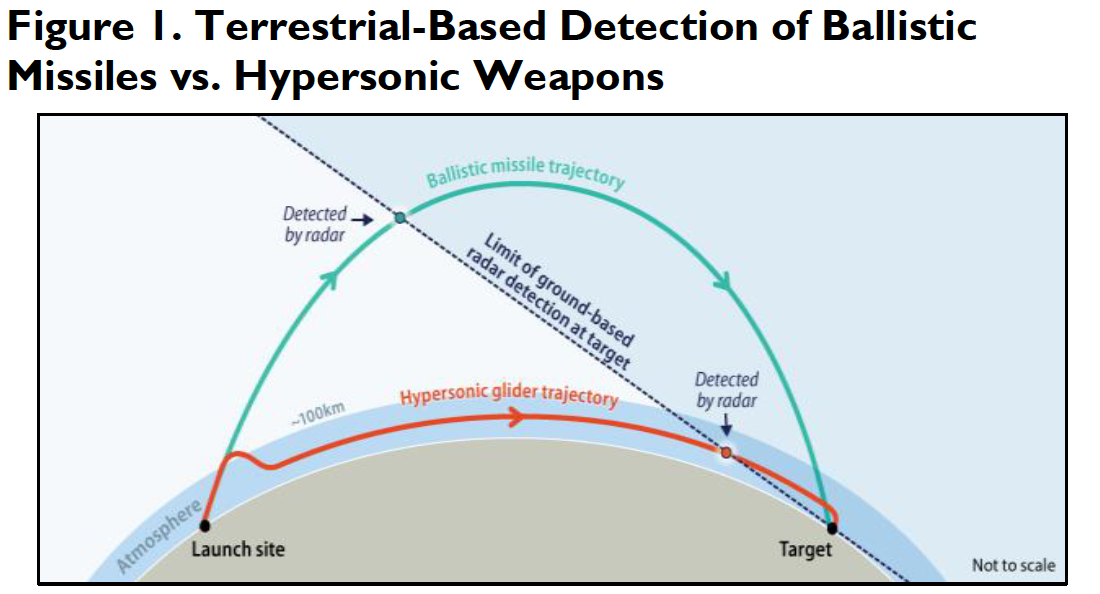The following is the Jan. 24, 2023, Congressional Research Service In Focus report, Hypersonic Missile Defense: Issues for Congress.
From the report
The Missile Defense Agency (MDA) and Space Development Agency (SDA) are currently developing elements of a hypersonic missile defense system to defend against hypersonic weapons and other emerging missile threats. These elements include the tracking and transport layers of the Proliferated Warfighter Space Architecture (PWSA) and various interceptor programs. As MDA and SDA continue to develop these systems, Congress may consider implications for oversight and defense authorizations and appropriations.
Background
Hypersonic weapons, like ballistic missiles, fly at speeds of at least Mach 5, or roughly 1 mile per second. Unlike ballistic missiles, hypersonic weapons do not follow a ballistic trajectory and can maneuver en route to their target. Russia reportedly fielded its first hypersonic weapons in December 2019, while some experts believe that China fielded hypersonic weapons as early as 2020. The United States is not expected to field hypersonic weapons before 2023. (For an overview of hypersonic weapons programs in Russia, China, and the United States, see CRS Report R45811, Hypersonic Weapons: Background and Issues for Congress, by Kelley M. Sayler.)
The maneuverability and low flight altitude of hypersonic weapons could challenge existing detection and defense systems. For example, most terrestrial-based radars cannot detect hypersonic weapons until late in the weapon’s flight due to line-of-sight limitations of radar detection. This leaves minimal time for a defender to launch interceptors that could neutralize an inbound weapon. Figure 1 depicts the differences in terrestrial-based radar detection timelines for ballistic missiles versus hypersonic weapons.
 U.S. defense officials have stated that both existing terrestrial- and space-based sensor architectures are insufficient to detect and track hypersonic weapons; former Under Secretary of Defense for Research and Engineering Mike Griffin has noted that “hypersonic targets are 10 to 20 times dimmer than what the U.S. normally tracks by satellites in geostationary orbit.”
U.S. defense officials have stated that both existing terrestrial- and space-based sensor architectures are insufficient to detect and track hypersonic weapons; former Under Secretary of Defense for Research and Engineering Mike Griffin has noted that “hypersonic targets are 10 to 20 times dimmer than what the U.S. normally tracks by satellites in geostationary orbit.”
Proliferated Warfighter Space Architecture
SDA developed the PWSA, formerly known as the National Defense Space Architecture, to “unify and integrate next generation capabilities across [the Department of Defense (DOD)] and industry.” The PWSA aims to be a “single, coherent proliferated space architecture with seven layers,” which include the data tracking and transport layers depicted in Figure 2 and discussed below. Other layers include the custody layer to support the targeting of mobile ground assets; the battle management layer to provide space-based command and control; the navigation layer to provide “alternate positioning, navigation, and timing for potential GPS-denied environments”; the deterrence layer to detect potentially hostile actions in deep space; and the support layer to facilitate satellite operations for the other PWSA layers. Once fully fielded, the PWSA is to include 550 satellites and provide full global coverage.
Tracking Layer
The tracking layer is to “provide global indications, warning, tracking, and targeting of advanced missile threats, including hypersonic missile systems.” As part of this layer, SDA is developing an architecture of Wide Field of View (WFOV) satellites, which are to eventually provide global coverage. SDA requested $81.3 million for Tranche 0 tracking activities in FY2023 and $499.8 million for Tranche 1 tracking activities (also known as Resilient Missile Warning Missile Tracking – Low Earth Orbit).
Working in tandem with the SDA’s tracking satellites will be the Hypersonic and Ballistic Tracking Space Sensor (HBTSS), previously known as the Space Sensor Layer, which is being developed by MDA in collaboration with SDA and the U.S. Space Force. HBTSS is to provide more sensitive, but more limited (or Medium Field of View [MFOV]) coverage, compared to WFOV. For this reason, WFOV is intended to provide cueing data to HBTSS, which could then provide more specific, target quality data to a ground-based interceptor. MDA requested $89.2 million for HBTSS in FY2023.
Download the document here.





